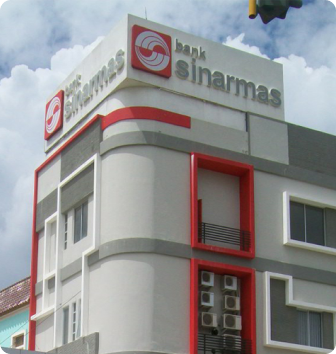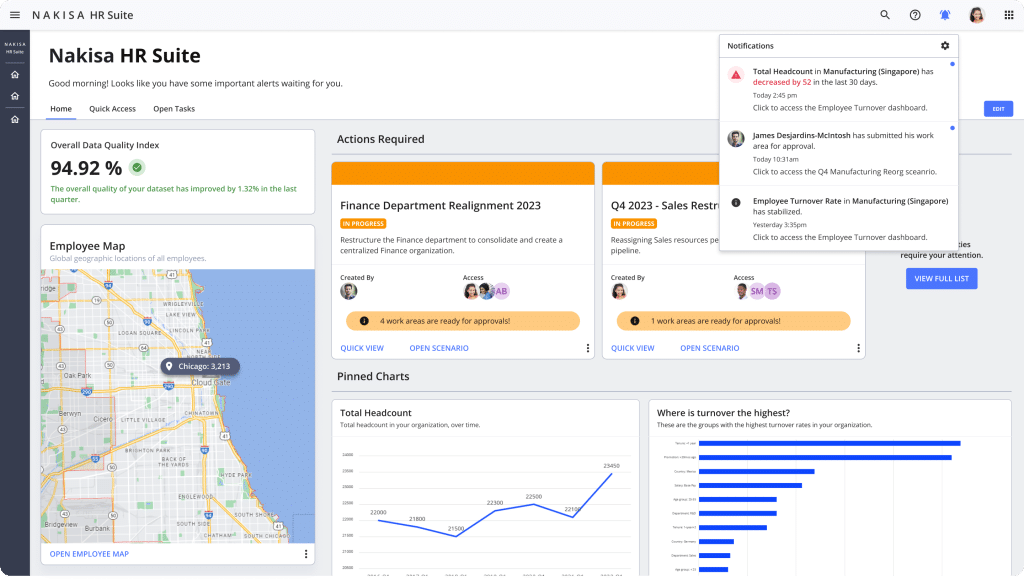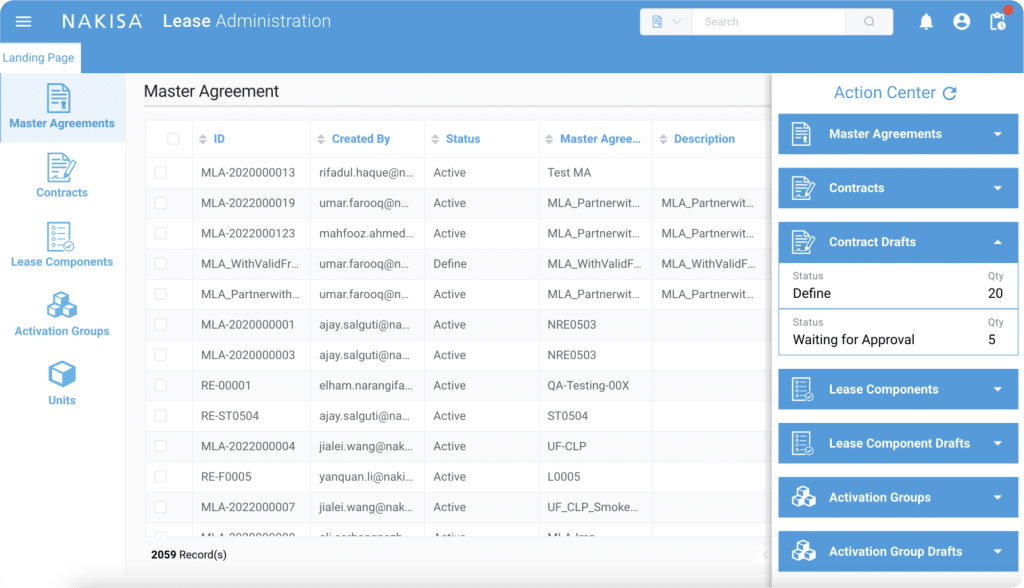Envision your long-term HR strategy with Nakisa's strategic workforce planning software

Key benefits of Nakisa's strategic workforce planning software
Strategic Vision 
Align workforce with strategic objectives
Decision-making and risk mitigation 
Make confident decisions backed by data
Cross-team Alignment 
Foster collaboration to get on the same page faster
Resource efficiency 
Optimize resource allocation by setting clear targets
STRATEGIC WORKFORCE PLANNING
Leverage a comprehensive strategic workforce planning workflow to secure the right talent for future success
Designed for large organizations with complex structures and dynamic workforce needs, Nakisa empowers you to make data-driven decisions that align talent with future business needs. With a few intuitive steps and the support of advanced analytics and scenario modeling, you can forecast upcoming needs based on your current state and future drivers, identify workforce gaps, and optimize talent strategies to stay ahead of changing market conditions.
Define the strategy and create initiatives with key attributes such as name, description, goals, and stakeholders. Then, determine two key elements:
– Time horizon: Determine the planning scope, such as long-term plan (3-5 years), medium-term (2-3 years), or short-term.
– Dimensions/Clusters: Categorize data by legal entity, business unit, function, job family, or location for deeper analysis and insights.
Analyze both talent (“supply pool”) and positions (“position pool”) using dashboards, trends, and key metrics, through a 5C framework:
– Capacity: Headcount, FTE, and position trends
– Cost: Salaries, compensation, and position budgets (including vacancies)
– Capabilities: Skills and competencies at both employee and position levels
– Composition: Role and skill distribution
– Configuration: Organizational structure (including spans and layers)
Define key drivers shaping the strategic initiative across three critical categories:
– Supply drivers: Attrition rates and retirements
– Market drivers: External factors like unemployment rates or inflation
– Demand drivers: Internal factors such as revenue growth targets, geographical expansion, and operational efficiency goals (e.g., organization optimization)
With the strategic initiative, current state, and future state drivers defined, you can now conduct a gap analysis. This step compares the current state to the future state using the 5C framework and dimensions to identify gaps in:
– Capacity: Headcount, FTE, and position trends
– Cost: Salaries, compensation, and position budgets (including vacancies)
– Capabilities: Skills and competencies at both employee and position levels
– Composition: Role and skill distribution
– Configuration: Organizational structure (including spans and layers)
Following the gap analysis, explore different scenarios to close the supply/demand gap using the 6B model for managing and optimizing a workforce. Analyze and select the most appropriate combination of “B” strategies to meet your business objectives effectively:
– Buy: Recruit new talent
– Borrow: Hire contractors
– Bot: Automate certain roles
– Build: Upskill or train existing employees
– Bounce: Reduce or transition certain roles
– Bind: Retain key talent
Monitor progress towards achieving the chosen scenario, with evaluations done monthly or quarterly. If necessary, recalibrate to ensure alignment with business goals. At this stage, based on your internal processes, you can begin operational or strategic organizational design and operational workforce planning.
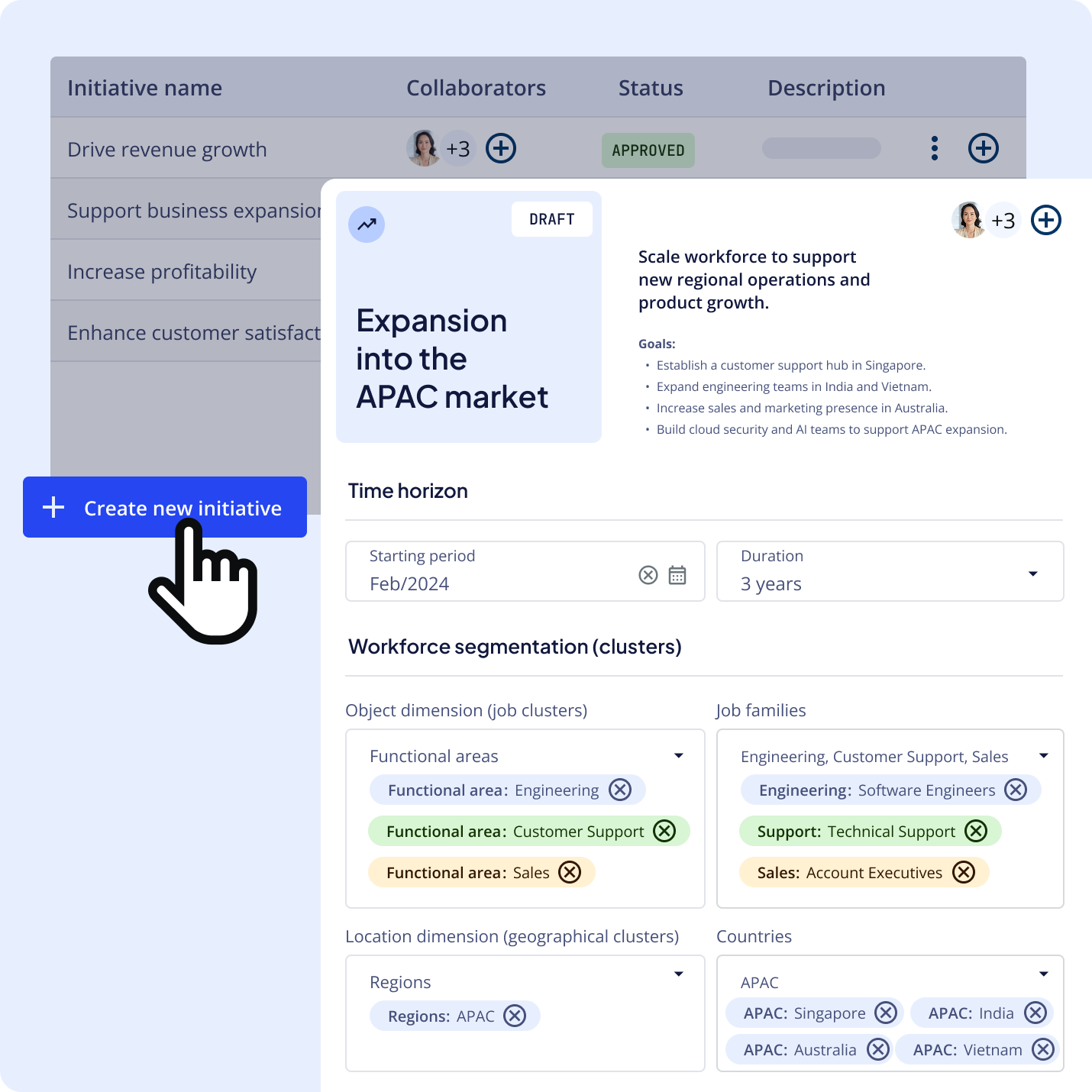

Strategic initiative creation, timeline, and cluster selection
Define the strategy and create initiatives with key attributes such as name, description, goals, and stakeholders. Then, determine two key elements: - Time horizon: Determine the planning scope, such as long-term plan (3-5 years), medium-term (2-3 years), or short-term. - Dimensions/Clusters: Categorize data by legal entity, business unit, function, job family, or location for deeper analysis and insights.
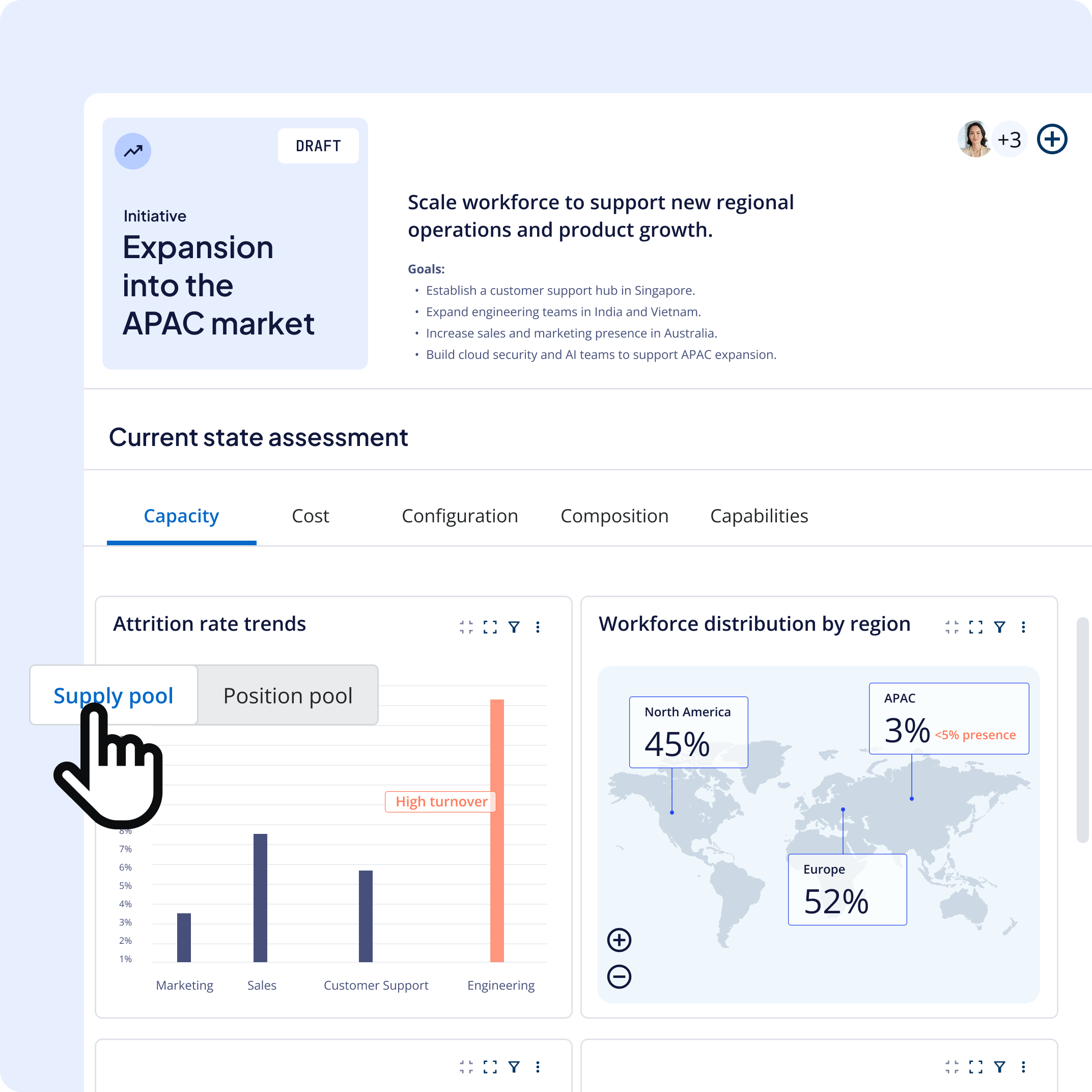
Current state assessment
Analyze both talent (“supply pool”) and positions (“position pool”) using dashboards, trends, and key metrics, through a 5C framework: - Capacity: Headcount, FTE, and position trends - Cost: Salaries, compensation, and position budgets (including vacancies) - Capabilities: Skills and competencies at both employee and position levels - Composition: Role and skill distribution - Configuration: Organizational structure (including spans and layers)
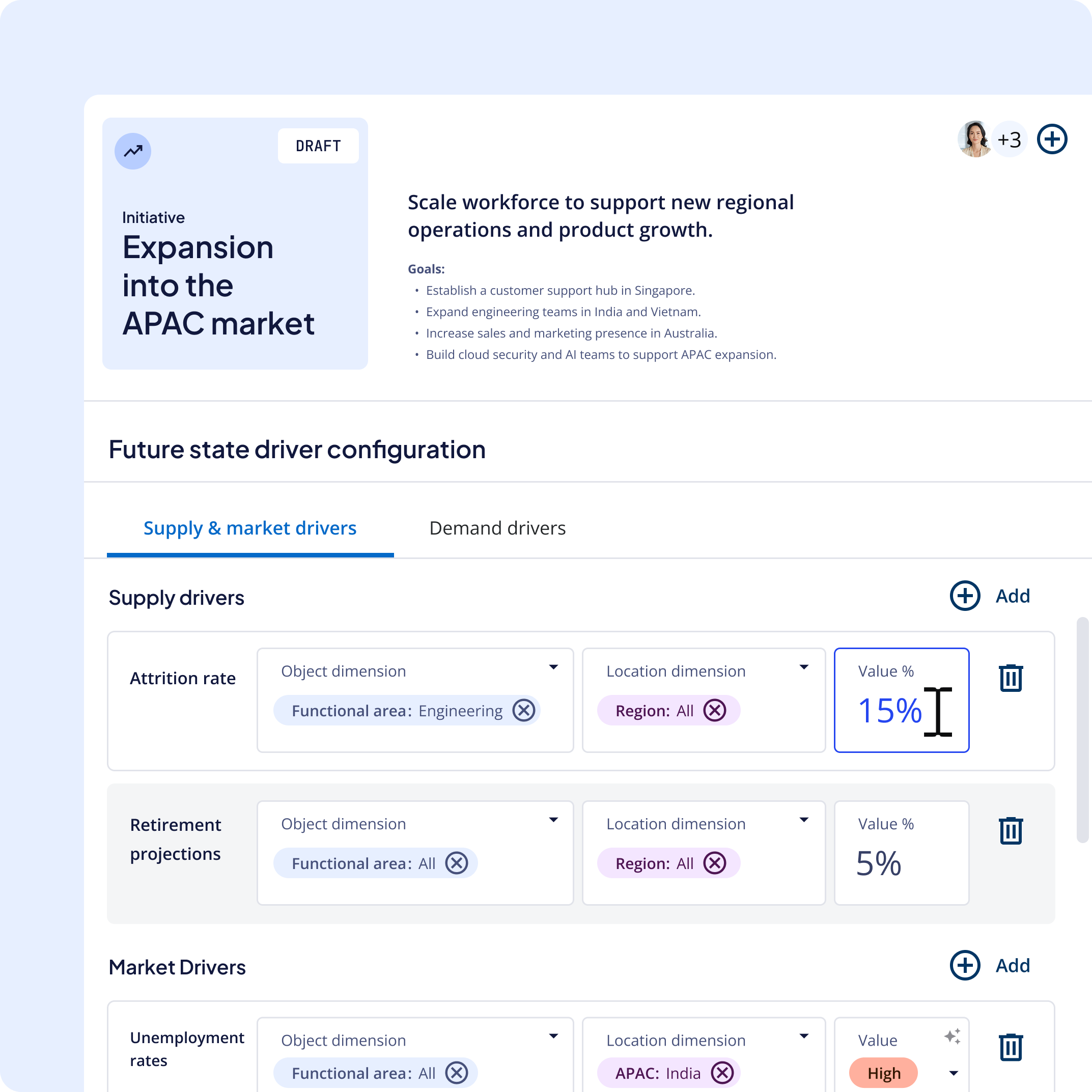
Future state driver configuration
Define key drivers shaping the strategic initiative across three critical categories: - Supply drivers: Attrition rates and retirements - Market drivers: External factors like unemployment rates or inflation - Demand drivers: Internal factors such as revenue growth targets, geographical expansion, and operational efficiency goals (e.g., organization optimization)
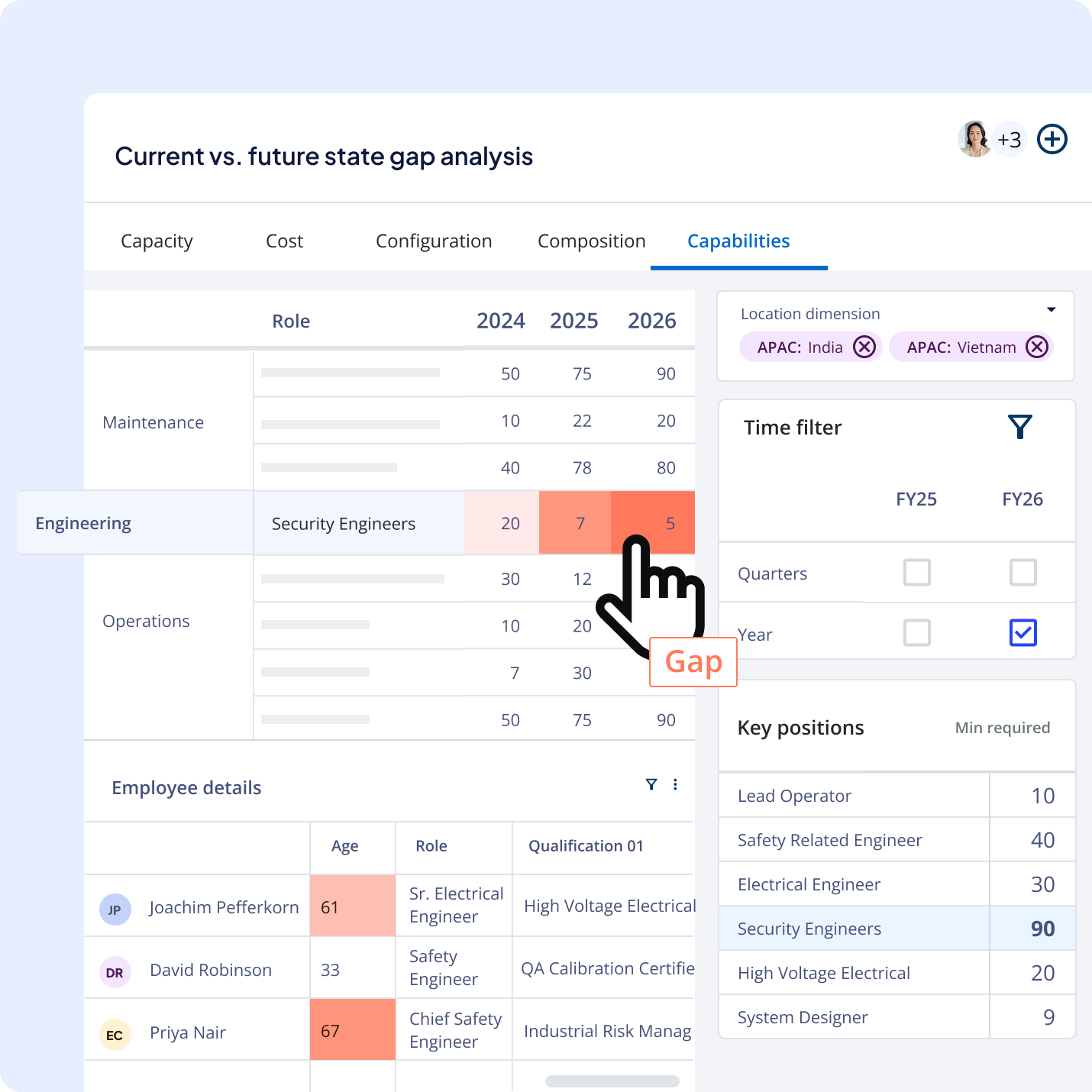
Gap analysis of current vs. future state
With the strategic initiative, current state, and future state drivers defined, you can now conduct a gap analysis. This step compares the current state to the future state using the 5C framework and dimensions to identify gaps in: - Capacity: Headcount, FTE, and position trends - Cost: Salaries, compensation, and position budgets (including vacancies) - Capabilities: Skills and competencies at both employee and position levels - Composition: Role and skill distribution - Configuration: Organizational structure (including spans and layers)
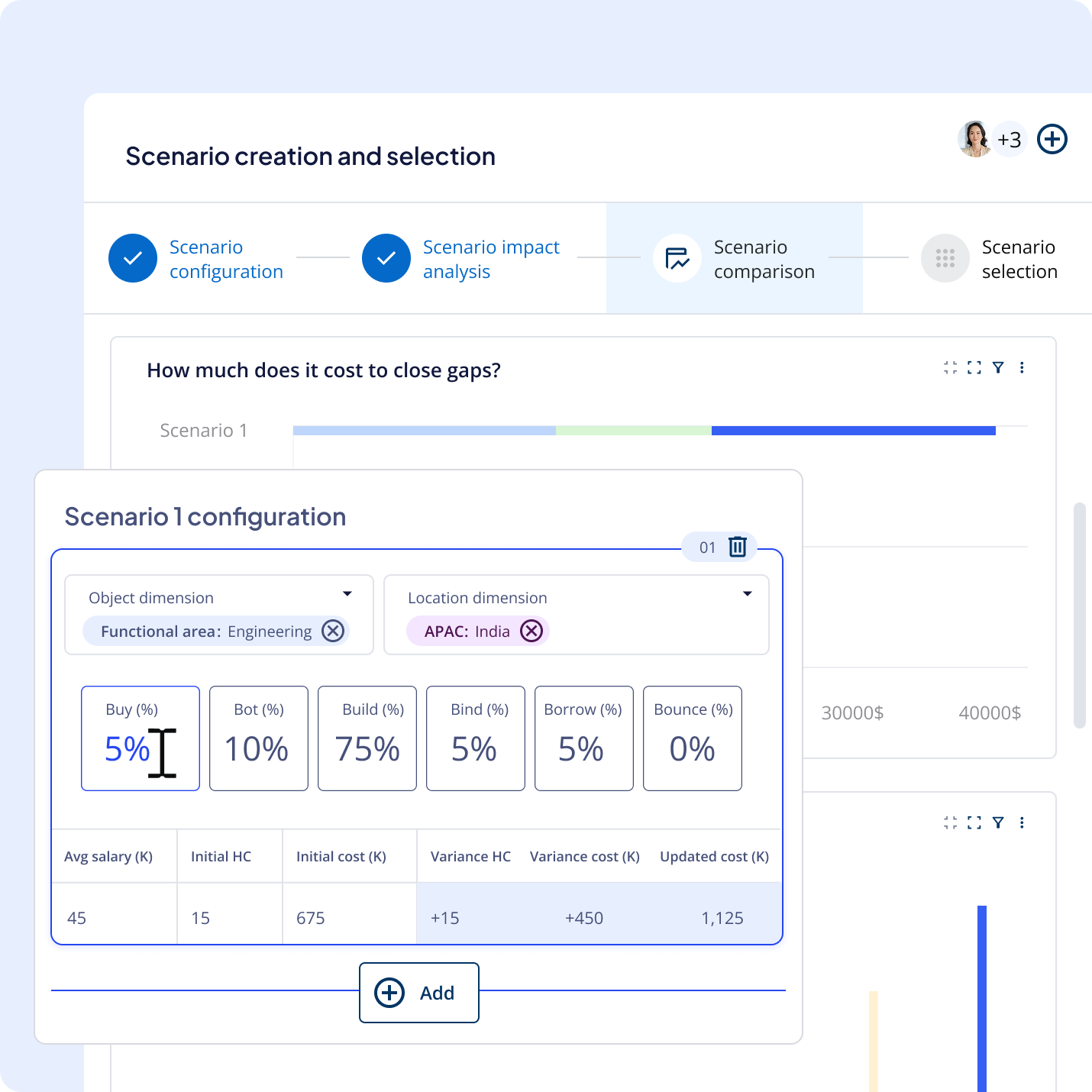
Scenario creation, comparison, and selection
Following the gap analysis, explore different scenarios to close the supply/demand gap using the 6B model for managing and optimizing a workforce. Analyze and select the most appropriate combination of "B" strategies to meet your business objectives effectively: - Buy: Recruit new talent - Borrow: Hire contractors - Bot: Automate certain roles - Build: Upskill or train existing employees - Bounce: Reduce or transition certain roles - Bind: Retain key talent
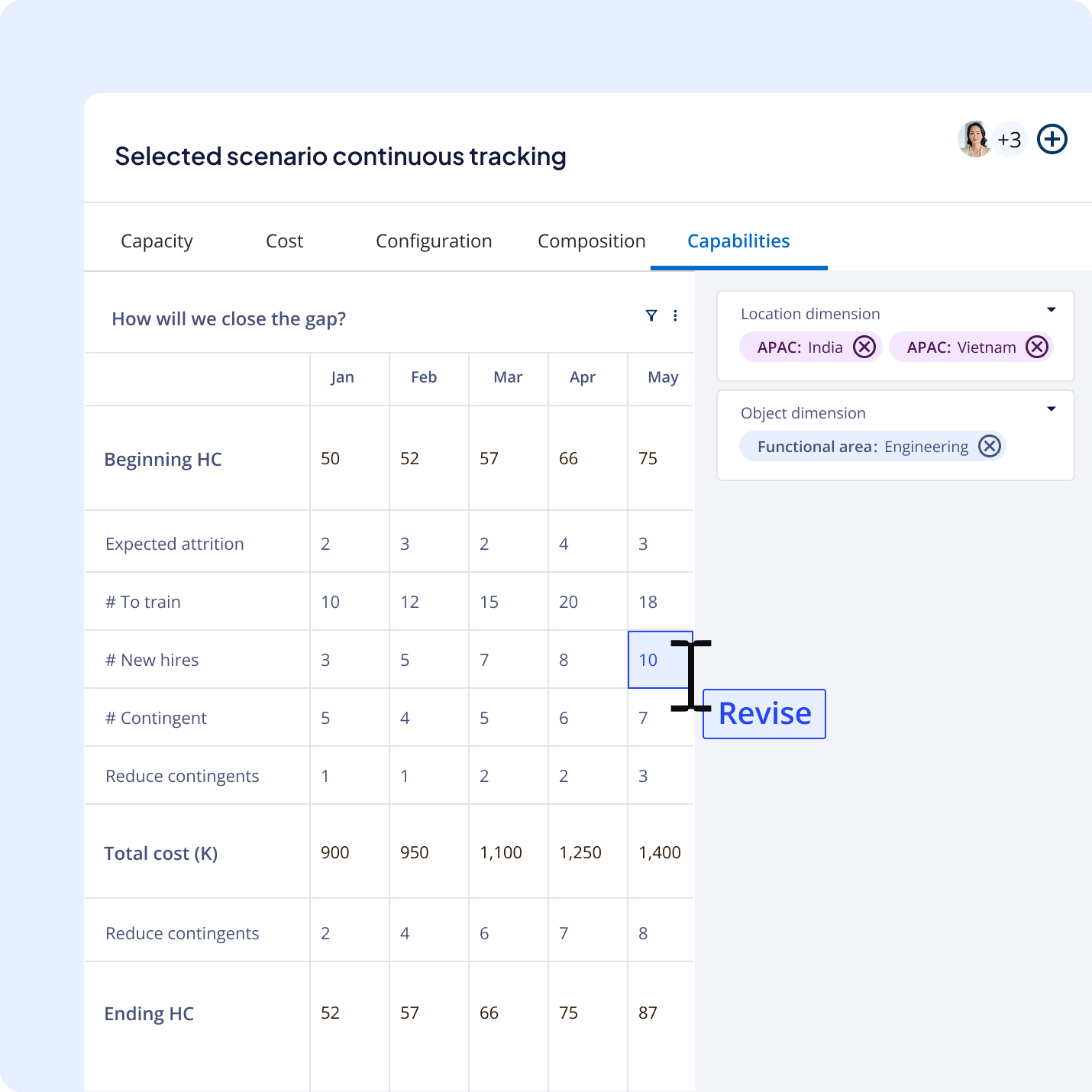
Selected scenario continued tracking
Monitor progress towards achieving the chosen scenario, with evaluations done monthly or quarterly. If necessary, recalibrate to ensure alignment with business goals. At this stage, based on your internal processes, you can begin operational or strategic organizational design and operational workforce planning.
With the strategic initiative, current state, and future state drivers defined, you can now conduct a gap analysis. This step compares the current state to the future state using the 5C framework and dimensions to identify gaps in:
– Capacity: Headcount, FTE, and position trends
– Cost: Salaries, compensation, and position budgets (including vacancies)
– Capabilities: Skills and competencies at both employee and position levels
– Composition: Role and skill distribution
– Configuration: Organizational structure (including spans and layers)
Following the gap analysis, explore different scenarios to close the supply/demand gap using the 6B model for managing and optimizing a workforce. Analyze and select the most appropriate combination of “B” strategies to meet your business objectives effectively:
– Buy: Recruit new talent
– Borrow: Hire contractors
– Bot: Automate certain roles
– Build: Upskill or train existing employees
– Bounce: Reduce or transition certain roles
– Bind: Retain key talent
Monitor progress towards achieving the chosen scenario, with evaluations done monthly or quarterly. If necessary, recalibrate to ensure alignment with business goals. At this stage, based on your internal processes, you can begin operational or strategic organizational design and operational workforce planning.
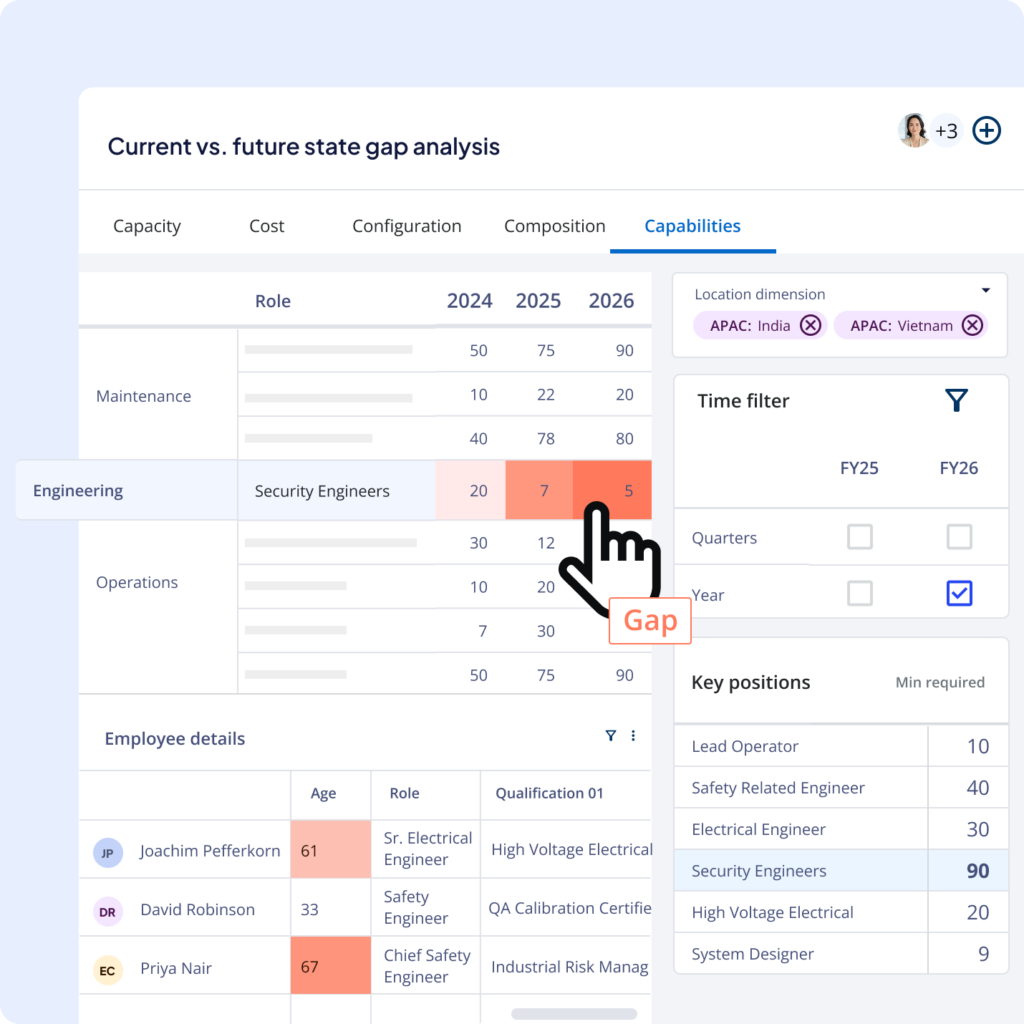

Gap analysis of current vs. future state
With the strategic initiative, current state, and future state drivers defined, you can now conduct a gap analysis. This step compares the current state to the future state using the 5C framework and dimensions to identify gaps in: - Capacity: Headcount, FTE, and position trends - Cost: Salaries, compensation, and position budgets (including vacancies) - Capabilities: Skills and competencies at both employee and position levels - Composition: Role and skill distribution - Configuration: Organizational structure (including spans and layers)

Scenario creation, comparison, and selection
Following the gap analysis, explore different scenarios to close the supply/demand gap using the 6B model for managing and optimizing a workforce. Analyze and select the most appropriate combination of "B" strategies to meet your business objectives effectively: - Buy: Recruit new talent - Borrow: Hire contractors - Bot: Automate certain roles - Build: Upskill or train existing employees - Bounce: Reduce or transition certain roles - Bind: Retain key talent

Selected scenario continued tracking
Monitor progress towards achieving the chosen scenario, with evaluations done monthly or quarterly. If necessary, recalibrate to ensure alignment with business goals. At this stage, based on your internal processes, you can begin operational or strategic organizational design and operational workforce planning.
OPERATIONAL WORKFORCE PLANNING
Align short-term headcount plans with business strategy and current workforce needs
Create detailed plans with specific headcount and budget targets. Monitor progress, adjust as needed, and stay on track towards your goals. Nakisa’s powerful analytics and intuitive interface provide clear insights to optimize staffing levels for immediate needs and future growth.
Accurately manage headcount planning
Accurately manage headcount planning by using data that's updated in real-time from integrated ERPs and assigning sub-areas of the headcount plan to separate budgets as needed.
Enhance operational workforce planning
Nakisa simplifies headcount planning at the team and departmental level by allowing users to easily communicate objectives, set targeted workforce goals, and make informed decisions about their teams' composition and growth.
Empower managers with collaborative planning
Nakisa empowers managers to plan their headcounts and collaborate with finance, HR, and any other stakeholder for a smooth workforce planning process across teams from the bottom-up. Collaborators stay informed of the current status and next steps via configurable notifications.
Easily finalize headcount plans
Centralize final headcount plans in a single source of truth to visualize key details on team structures, hiring gaps, and plan outcomes. Streamline proposal approvals to ensure alignment with business goals and budget constraints.
Understand the impact of your choices
AI-powered advanced analytics and intuitive reporting help you track and interpret your headcount plan's results over time. Quickly identify key trends and metrics to make data-driven, informed staffing adjustments that align with real business needs.
More functionality to enhance your strategic workforce planning
Real-time visibility of your workforce
Harmonize your enterprise HR data from various sources, ensuring data accuracy and integrity. Nakisa presents vast amounts of real-time data in easy-to-understand formats, letting you effortlessly extract value from it. Quickly move to actionable insights, facilitating accurate and prompt decision-making.
Native bidirectional ERP integrations
Nakisa's software natively integrates bidirectionally with SAP HCM, SAP SuccessFactors, Workday, Oracle, and other ERP and HCM systems to ensure that your HR data is always complete and up to date. Experience smooth data synchronization and focus on interpreting data rather than managing it.
Compliance and role-based access
Role-based access control (RBAC) ensures that only the right managers, assistants, and HR stakeholders have access to your headcount planning processes and data. Nakisa satisfies a wide range of standards for optimal compliance and security, including SOC 1, SOC 2, SOC 3, C5 (Germany), Cyber Essentials Plus (UK), DoD SRG, FedRAMP, FIPS, IRAP (Australia), ISO 9001, ISO 27001, ISO 27017, ISO 27018, MLPS Level 3 (China), MTCS (Singapore), PCI DSS Level 1, and SEC Rule 17a-4(f).
Chat, notifications, and streamlined approval process
Break down silos and logjams to get fast headcount plan approvals. Assign parts of the headcount plan to dedicated teams, collaborate, and chat directly in the app to get faster input and buy-in.
UI, onboarding, and support
Enjoy a UI designed for easy navigation, regardless of users' technical skill levels. Intuitive interfaces, reports, and dashboards are available out-of-the-box and can be easily configured.
If you need any guidance, Nakisa offers onboarding and training services supported by experts experienced in complex environments. Our 24/7/365 support team, client portal and materials are here to answer all your questions.
Designed for global enterprises
Benefit from stable and scalable software that adjusts to your business growth needs. Nakisa has exceptional performance with uptime availability of 99.5% and offers regular continuous product updates and innovations. Global enterprises benefit from multiple-language support and compliance standards for various countries and regions.
More functionality to enhance your strategic workforce planning
Real-time visibility of your workforce
Native bidirectional ERP integrations
Compliance and role-based access
Chat, notifications, and streamlined approval process
UI, onboarding, and support
Enjoy a UI designed for easy navigation, regardless of users’ technical skill levels. Intuitive interfaces, reports, and dashboards are available out-of-the-box and can be easily configured.
If you need any guidance, Nakisa offers onboarding and training services supported by experts experienced in complex environments. Our 24/7/365 support team, client portal and materials are here to answer all your questions.
Designed for global enterprises
Benefit from stable and scalable software that adjusts to your business growth needs. Nakisa has exceptional performance with uptime availability of 99.5% and offers regular continuous product updates and innovations. Global enterprises benefit from multiple-language support and compliance standards for various countries and regions.
Let's have a no-obligation call!
We can discuss your particular case and show what benefits Nakisa’s strategic workforce planning software can bring to your company.
Unlock a comprehensive workforce planning portfolio for your operational excellence
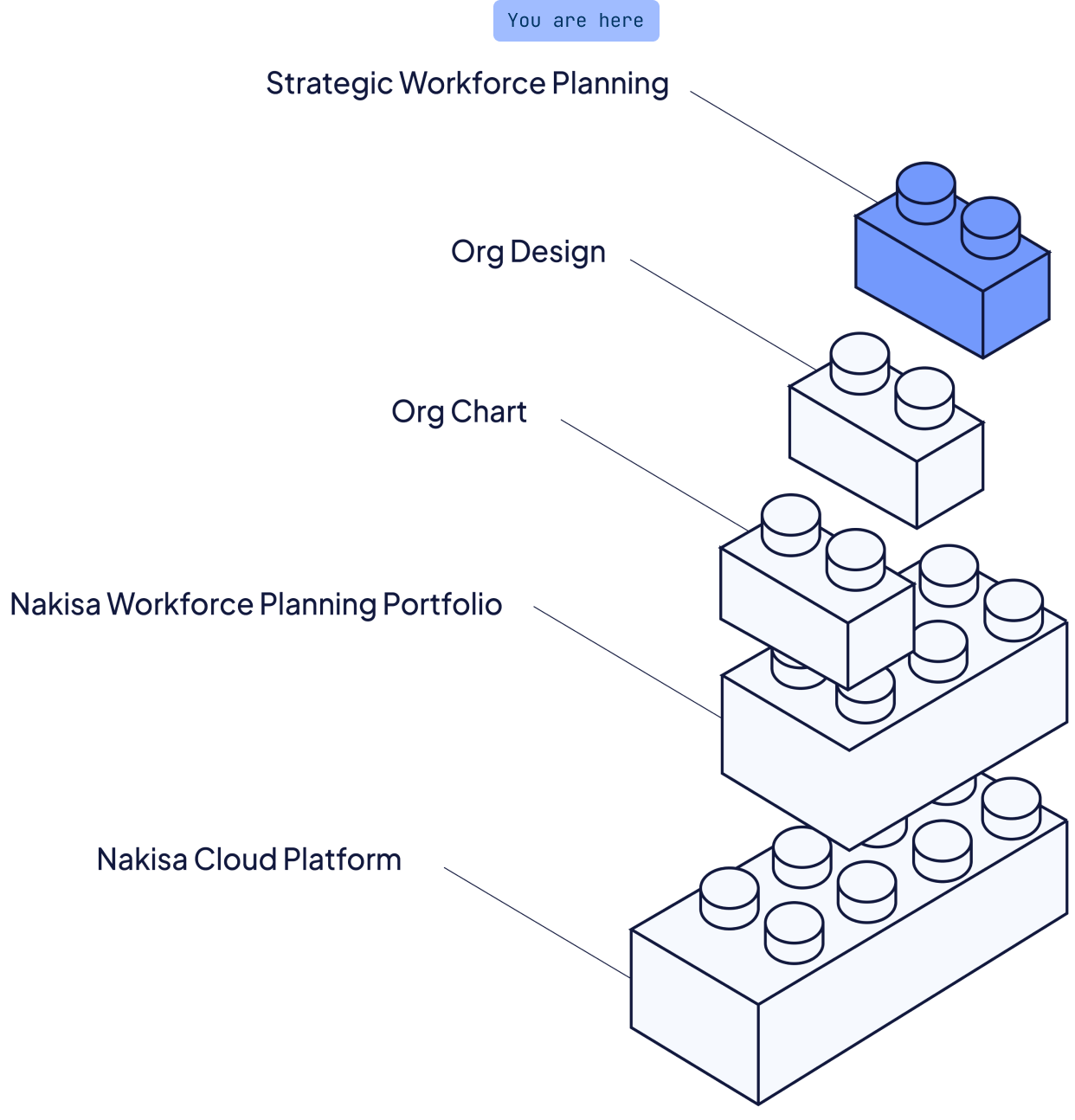
What others say about Nakisa
All in all, the process could take up to 38 days to complete the org change. With the write-back, the end-to-end org change process now takes under 5 days… It is a huge win for our HR group.

Huge time savings were achieved through filtering, slicing, and dicing of data based on different dimensions such as layers, business lines, regions, countries, functions, and products. Reports that took 2−6 hours to create in the past, were now being instantly generated in Nakisa Workforce Planning.”
Even as we go through a rapid growth period, Nakisa was able to fully integrate to our ERP system in real-time and handle our ongoing transformation needs in it’s stride. An unexpected benefit as we started using [the system] was the ability to identify data quality issues in our ERP, something we had no visibility of previously
Ready to streamline your strategic workforce planning?
Our experts are here to discuss your unique business requirements and provide a demo of our strategic workforce planning software tailored to your needs.


